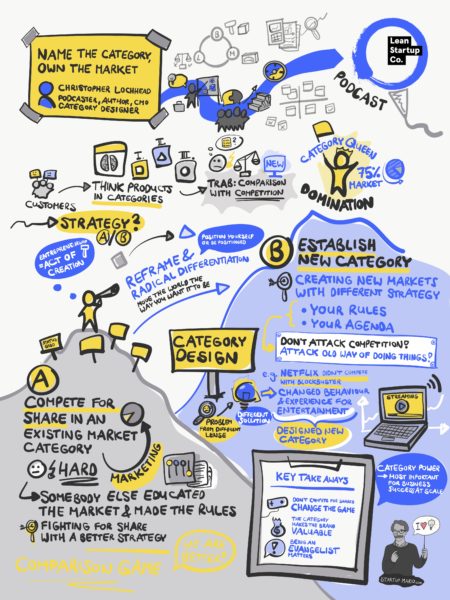Name The Category, Own The Market

Christopher Lochhead values standing out over fitting in. He wants entrepreneurs to create markedly different products, not just better versions of old standbys. His #1 charting podcasts, “Follow Your Different” and “Lochhead on Marketing,” and bestselling books Niche Down: How To Become Legendary By Being Different and Play Bigger: How Pirates, Dreamers, and Innovators Create and Dominate Markets instruct entrepreneurs on developing and dominating new categories of products and services—and shifting consumer paradigms in the process. Lochhead eschews conventional marketing wisdom and evangelizes “category design,” which he calls “a secret art built on the thinking of legends.”
Lean Startup Co. advisor Christopher Guest recently chatted with Lochhead to understand why category design is so powerful, how to best wield it, and why entrepreneurs should naturally embody it. Below are the highlights of their lively conversation.
[one-half-first]
 [/one-half-first]
[one-half]
[/one-half-first]
[one-half]
 [/one-half]
[/one-half]
Category Design is Powerful– Just Ask Spanx and Netflix
Category design is the business discipline of rethinking standard approaches to problems and opportunities, and opening customers up to bold new possibilities. Its leaders and disciples proactively position themselves as the “designer, the creator, and therefore the de facto standard” of the product or service they offer, says Lochhead. They’re not bothering with chasing market shares in pre-existing categories.
“The company that designs the space is best positioned to dominate it,” Lochhead says, adding that category queens earn 75% of the economics, or total market cap of all the companies in said category. In the startup world, companies that design and dominate giant market categories are creating enduring value for their stakeholders over the long haul. “Those are the companies that are valued both economically and on other dimensions in the world,” he says.
Consumers naturally put all the products and services they’re exposed to into categories, so why not beat them to the punch? Lochhead says companies must “position themselves or be positioned,” adding that the fundamental argument of category design is that the category makes the brand—not the other way around.
Category design is rooted partially in language. Spanx is a multi-billion dollar category inside the undergarment world in part because founder Sara Blakely defined her new product against the old world of control top pantyhose, says Lochhead. By changing the demarcation point in language, entrepreneurs are creating a “demarcation point in action, purchasing, consumption, and behavior.”
Netflix is another excellent example of category design. Lochhead says their success wasn’t solely hinged upon how their service compared to the alternatives, how good their technology held up, or whether they were a first mover in the streaming space. There’s value in all those attributes, but Lochhead asserts those things are overvalued compared to the founders’ biggest achievement: “They taught the world how to think about the acquisition of entertainment completely differently. They thought about the problem from a different lens, and therefore they created a completely different lens solution.”
Instead of competing with Blockbuster, he adds, Netflix “had a provocative point of view about the experience of media consumption. It was not incrementally better, it was exponentially different.” The company’s POV changed customer attitudes on accessing movies and television. Netflix didn’t play the comparison game, they changed the game completely.
“The company that designs the space is best positioned to dominate it.” Click To TweetCategory Design Gets You Out of the Comparison Trap
Most entrepreneurs fall into a competition trap where they’re trying to one-up category leaders. Lochhead advocates for leaving the competition behind by designing a new way of thinking—that way, when the world agrees with you at scale, you’ll be onto something really big.
He gives the example of Dyson. Back in the ‘90s, vacuum cleaner companies were competing on features like suction power, cord length, and flashing lights, says Lochhead. He says Dyson came along with an attitude of, “Listen, everything you hate about your vacuum cleaner is because of the bag. It’s messy, you drop it when you go to change it—it just sucks. You need a vacuum cleaner without a bag.” The company created the bagless vacuum category, a standard by which vacuum cleaners have since been compared.

She Who Best Explains The Problem Is Primed to Own The Solution
Category design moves the world from the way it is to the way you want it to be, says Lochhead. Marc Benioff famously took this approach with Salesforce when he aimed for radical differentiation by naming the alternative way of doing business “on premise.”
“He named the [competing] category in a functionally, technically accurate way. There’s nothing pejorative on the surface of on-premise software,” says Lochhead. “He needed to establish on premise before he could establish cloud, [at the time] no software had that point of view.” This strategy allowed Benioff to categorically attack the approach his competitors took without having to name names.
“There’s only two categories,” at that point, says Lochhead, “the category of companies that agree with your point of view and those that don’t.”
The fundamental argument of category design is that the category makes the brand—not the other way around. Click To TweetSet the Agenda in a Space That Matters
Lochhead says we’re now at a point where founders seeking funding are expected to “articulate a category strategy that massively differentiates [them] and makes [them] the agenda setter in a giant space that matters.”
He adds that this is also just good business sense. If you don’t boldly distinguish your product or service from everything that came before, you will get compared to everything that came before. “The breakthroughs of the future do not sit inside of the thinking and the paradigms of the past.” The more innovative your concept, he says, the more you should be radically differentiating it such “that you become the de facto standard in the new thing.”
Lochhead gives the example of Memphis Meats, a food tech company evangelizing a new category of cell-based meat. “They’re out there building this category akin to what Henry Ford did with the horseless carriage. Is it going to work? I don’t know. But what I do know is that they’re being intentional about evangelizing this radically different kind of meat,” says Lochhead.
Category Design Favors the Bold
If you’re comfortable with outsourcing the way people think about your company and the criteria by which you’re measured, then by all means don’t use category design, says Lochhead. “It takes a tremendous amount of courage to stand up and say, ‘It’s like this now, but it’s going to be this whole other way in the future.’” But entrepreneurs are by nature engaged in an act of bringing something forth from nothing, in many cases in the face of massive resistance. “Entrepreneurs are the creators who slay the cynicism of our times with their dreams. And you have to be willing to stand up for your dream and teach the world how to think about things in a new way.”
Not all category designers are anti-establishment by nature, notes Lochhead. He gives the example of Workday, which grew its base through the earnest tone set by its founders. “They have a warm brand, they come across as genuine people, and their brand is, ‘Hey, we’re nice guys doing leading edge shit, convert to us,’” Lochhead says. There are a number of different ways to change public perception. “The way you do it needs to be authentically in the personality of the company, of the founders, and of the inventors,” he says.
Thanks to Jennifer Maerz for writing this blog piece. If you seek to bring the entrepreneurial spirit to your organization, Lean Startup Co. can help.

